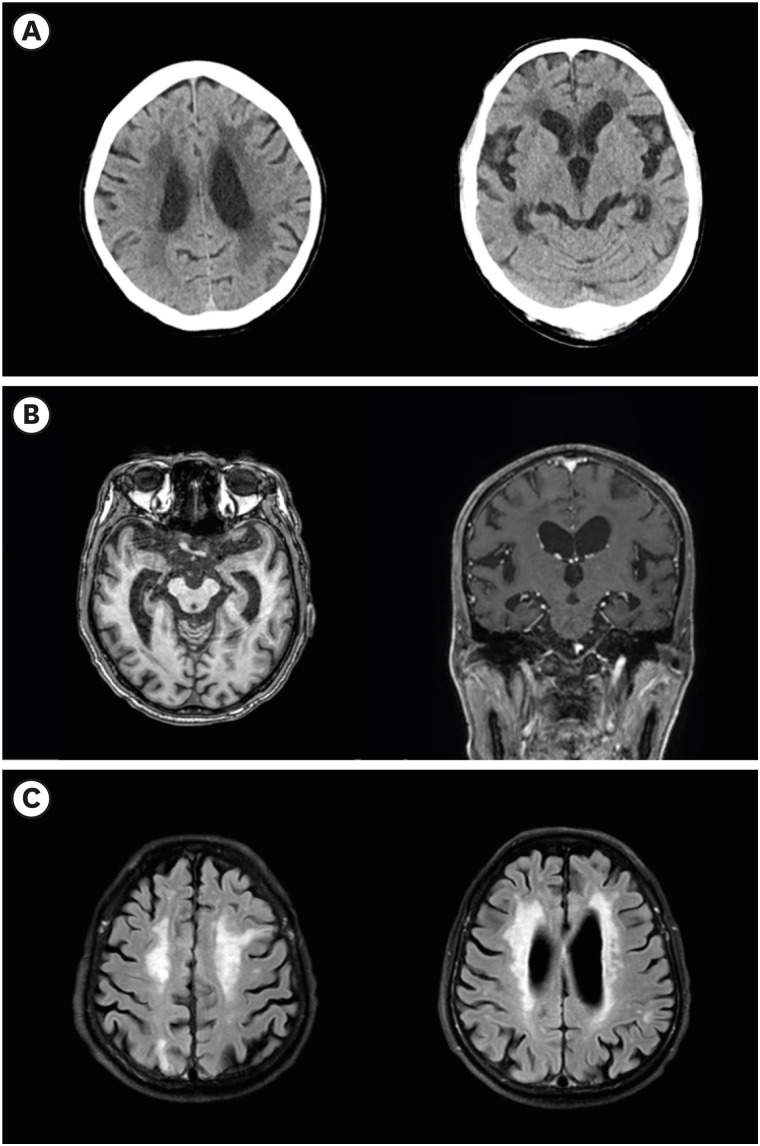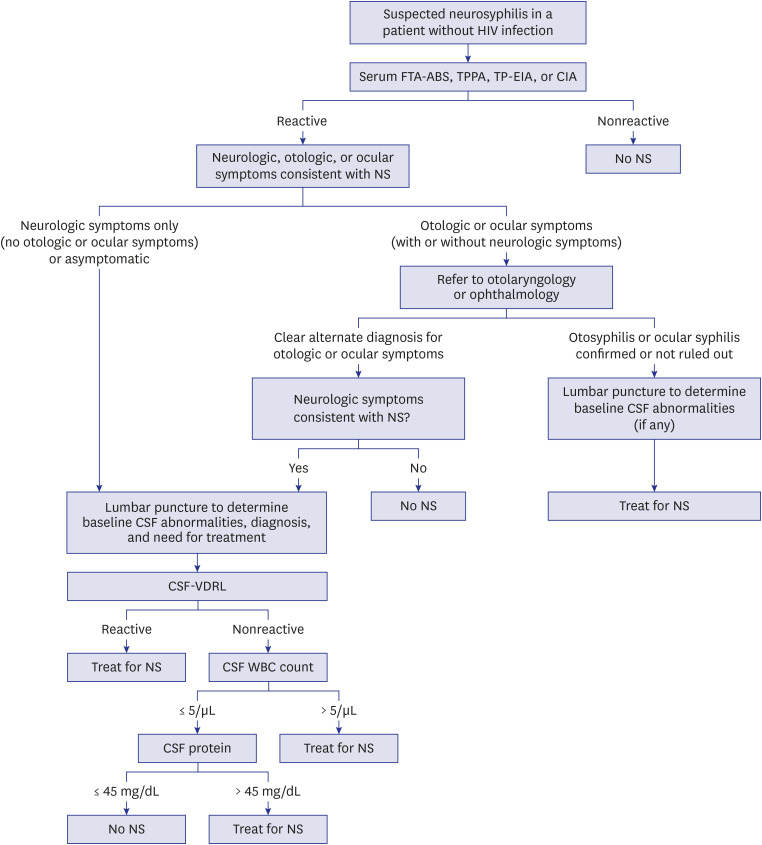J Korean Med Sci.
2020 Aug;35(33):e271. 10.3346/jkms.2020.35.e271.
Re-emerging Neurosyphilis in Korea as a Possible Etiology of Psychotic Disorders with Pleomorphic Symptoms and Cognitive Dysfunction: a Case Report and Literature Review
- Affiliations
-
- 1Department of Neuropsychiatry, Jeju National University Hospital, Jeju, Korea
- 2Department of Neuropsychiatry, Jeju National University School of Medicine, Jeju, Korea
- KMID: 2505591
- DOI: http://doi.org/10.3346/jkms.2020.35.e271
Abstract
- Infectious diseases of immigrant populations have recently become important issues for the health of both Korean nationals and foreigners living in Korea. This case report of general paresis is intended to raise awareness about re-emerging neurosyphilis in Korea as a possible etiology of psychotic disorders. A 68-year-old male Chinese resident came to Korea in 2019 with disorientation, auditory hallucination, persecutory delusion, and aggressive behavior, and was admitted to a psychiatric ward for further evaluation and treatment via the emergency department. He was confirmed to have neurosyphilis by serum test, analysis of cerebrospinal fluid, and brain magnetic resonance imaging. After treatment with antibiotics, including intravenous penicillin, in combination with atypical antipsychotics for 6 weeks, his disorientation, auditory hallucination, delusion, and aggressive behavior had attenuated. Neurosyphilis should still be included as a possible etiology of psychotic disorders in Korea. At the initial evaluation, syphilis screening serum tests are recommended for psychotic patients, especially those with pleomorphic symptoms and cognitive dysfunction.
Figure
Reference
-
1. Jantzen SU, Ferrea S, Langebner T, Gaebel W, Griese M, Arendt G, et al. Late-stage neurosyphilis presenting with severe neuropsychiatric deficits: diagnosis, therapy, and course of three patients. J Neurol. 2012; 259(4):720–728. PMID: 21964751.
Article2. Rubin AN, Espiridion ED, Truong NH, Lofgren DH. Neurosyphilis presenting with anxiety: a case report. Cureus. 2018; 10(7):e3020. PMID: 30254809.
Article3. Roberts MC, Emsley RA. Psychiatric manifestations of neurosyphilis. S Afr Med J. 1992; 82(5):335–337. PMID: 1448714.4. Kim CK. A clinical study of neurosyphilis. J Korean Neuropsychiatr Assoc. 1975; 15:119–125.6. Park J, Kwon KY. Reversible dementia with middle cerebellar peduncle hyperintensity: 1-year follow-up of HIV-negative neurosyphilis. J Clin Neurol. 2017; 13(4):437–438. PMID: 28831790.
Article7. Seo EH, Yang HJ, Kim SH, Park JH, Yoon HJ. Psychotic mania as the solitary manifestation of neurosyphilis. Ann Gen Psychiatry. 2018; 17(1):24. PMID: 29928290.
Article8. MacPherson DW, Gushulak BD. Syphilis in immigrants and the Canadian immigration medical examination. J Immigr Minor Health. 2008; 10(1):1–6. PMID: 17562180.
Article9. Ministry of the Interior and Safety. The Survey of Foreign Residents in Korea, 2018. Sejong: Ministry of the Interior and Safety;2019.10. Yeom JS, Kwon KT, Lee J, Suh YB, Cheong HS, Kwon HH, et al. Vaccination guideline for Immigrant in Korea by Korean Society of Infectious Diseases. Infect Chemother. 2015; 47(2):145–153. PMID: 26157598.
Article11. Choi JK, Lee SJ, Yoo JH. History of syphilis and gonorrhea in Korea. Infect Chemother. 2019; 51(2):210–216. PMID: 31271002.
Article12. Fazekas F, Chawluk JB, Alavi A, Hurtig HI, Zimmerman RA. MR signal abnormalities at 1.5 T in Alzheimer's dementia and normal aging. AJR Am J Roentgenol. 1987; 149(2):351–356. PMID: 3496763.
Article13. Workowski KA, Bolan GA. Centers for Disease Control and Prevention. Sexually transmitted diseases treatment guidelines, 2015. MMWR Recomm Rep. 2015; 64(RR-03):1–137.14. Marra CM. Neurosyphilis. Updated 2018. Accessed April 8, 2020. https://www.uptodate.com/contents/neurosyphilis?search=neurosyphilis&source=search_result&selectedTitle=1~70&usage_type=default&display_rank=1.15. Marra CM, Maxwell CL, Tantalo L, Eaton M, Rompalo AM, Raines C, et al. Normalization of cerebrospinal fluid abnormalities after neurosyphilis therapy: does HIV status matter? Clin Infect Dis. 2004; 38(7):1001–1006. PMID: 15034833.
Article16. Lee JP, Koo SH, Jin SY, Kim TH. Experience of meningovascular syphilis in human immunodeficiency virus infected patient. J Korean Neurosurg Soc. 2009; 46(4):413–416. PMID: 19893736.
Article17. Jeong YM, Hwang HY, Kim HS. MRI of neurosyphilis presenting as mesiotemporal abnormalities: a case report. Korean J Radiol. 2009; 10(3):310–312. PMID: 19412521.
Article18. Lee CW, Lim MJ, Son D, Lee JS, Cheong MH, Park IS, et al. A case of cerebral gumma presenting as brain tumor in a human immunodeficiency virus (HIV)-negative patient. Yonsei Med J. 2009; 50(2):284–288. PMID: 19430565.
Article19. Yoon YK, Kim MJ, Chae YS, Kang SH. Cerebral syphilitic gumma mimicking a brain tumor in the relapse of secondary syphilis in a human immunodeficiency virus-negative patient. J Korean Neurosurg Soc. 2013; 53(3):197–200. PMID: 23634274.
Article20. Nyangoma EN, Olson CK, Painter JA, Posey DL, Stauffer WM, Naughton M, et al. Syphilis among U.S.-bound refugees, 2009-2013. J Immigr Minor Health. 2017; 19(4):835–842. PMID: 26993114.
Article21. Ministry of Unification. Settlement support for North Korean defectors. Updated 2020. Accessed April 8, 2020. https://www.unikorea.go.kr/unikorea/business/NKDefectorsPolicy/status/lately.22. Jones HD, Urquhart N, Mathias RG, Banerjee SN. An evaluation of oligoclonal banding and CSF IgG index in the diagnosis of neurosyphilis. Sex Transm Dis. 1990; 17(2):75–79. PMID: 2193408.
Article23. Caudie C, Garel F, Bancel J, Lombard C, Vandenberghe N. Diagnosis and biological monitoring of 6 neurosyphilis cases: value of cerebrospinal fluid analysis. Ann Biol Clin (Paris). 2003; 61(5):563–569. PMID: 14671754.
- Full Text Links
- Actions
-
Cited
- CITED
-
- Close
- Share
- Similar articles
-
- Stuttering Priapism in a Patient with Neurosyphilis
- Neurosyphilis Presenting with Non-Convulsive Status Epilepticus
- Psychiatric Symptoms in Systemic Lupus Erythematosus: Diagnosis and Treatment
- Behavioral and Psychological Symptoms in Dementia(BPSD):Psychotic Symptoms
- Neurosyphilis as a Rare Cause of Mild Cognitive Impairment and Depression: Two Case Reports and Literature Review



